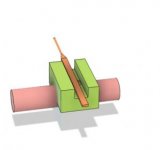wehnelt
Aluminum
- Joined
- Apr 13, 2007
- Location
- California
I have a bit of a hell-project.
* I have a 1/4" diameter, 6 foot long piece of stainless steel tube between two flanges
* It has a tiny 1/16" dent in it.
* It must be worked in situ (welded to a $30,000 piece of scientific equipment). No turning.
* It must slide against an o-ring sliding seal (no abrasives can embed themselves in the surface).
* The sliding seal separates the atmosphere from a chamber filled with a rare isotope of Helium. (can't goof this up.)
* I can't work from the inside of the tube since it's filled with wires (No ball-sizing.)
How do I make the surface round again so it'll seal against the o-ring? I think I should fill it with silver solder, but what then? A little 600 grit sandpaper to finish it will be fine as I don't expect too much grit to detach and embed, but I don't think making a fully splittable lap and filling it with lapping paste is acceptable. I'm mostly concerned with doing the majority of the material removal. How do I file it round without mucking up the surrounding stainless? Is there some kind of filing guide I could make? Someone on the machinists facebook group suggested I scrape it using a v-block. That sounded promising.
Any ideas, folks?
* I have a 1/4" diameter, 6 foot long piece of stainless steel tube between two flanges
* It has a tiny 1/16" dent in it.
* It must be worked in situ (welded to a $30,000 piece of scientific equipment). No turning.
* It must slide against an o-ring sliding seal (no abrasives can embed themselves in the surface).
* The sliding seal separates the atmosphere from a chamber filled with a rare isotope of Helium. (can't goof this up.)
* I can't work from the inside of the tube since it's filled with wires (No ball-sizing.)
How do I make the surface round again so it'll seal against the o-ring? I think I should fill it with silver solder, but what then? A little 600 grit sandpaper to finish it will be fine as I don't expect too much grit to detach and embed, but I don't think making a fully splittable lap and filling it with lapping paste is acceptable. I'm mostly concerned with doing the majority of the material removal. How do I file it round without mucking up the surrounding stainless? Is there some kind of filing guide I could make? Someone on the machinists facebook group suggested I scrape it using a v-block. That sounded promising.
Any ideas, folks?




